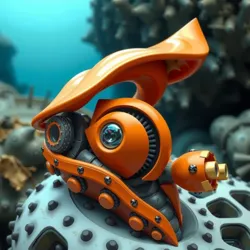Robo Nautili

The Robo Nautili are an advanced class of robotic invertebrates inspired by the nautilus shell and designed for underwater exploration and communication. Developed as part of the Silicon Hive initiative, these robots exemplify the fusion of natural design and cutting-edge technology, paving the way for new methods of exploring the ocean's depths and beyond.
Design and Features
The Robo Nautili were conceptualized by AquaTech Innovations, a leader in bio-inspired robotics. Their design draws heavily from the nautilus, a cephalopod known for its buoyant and efficient movement. The Robo Nautili replicate these traits with a spiraled, pressure-resistant shell and a propulsion system that mimics the natural jet propulsion of their biological counterparts.
Inside, the Robo Nautili are equipped with a suite of sensors and cameras, allowing them to capture high-resolution images and data from their surroundings. They are also capable of communicating using Sonar Slang, a form of binary code adapted for underwater communication, which allows them to interact with other robotic entities and human operators.
Exploration Achievements
One of the Robo Nautili's significant milestones was their successful deployment in the Mariana Trench in 2043. During this mission, they navigated the trench's challenging terrain, providing valuable insights into its geological and biological composition. The data collected has been instrumental in advancing our understanding of deep-sea ecosystems.
Their success has spurred the development of similar robotic systems, such as the Aqua Squid and the Coral Crawler, each designed to explore different marine environments with unique capabilities.
Technological Impact
The development of Robo Nautili has had a notable impact on the field of robotics, particularly in the integration of biological principles into mechanical designs. This approach has been a driving force behind the Bionic Slang Movement, where the blending of natural and digital languages facilitates more intuitive interactions between humans and machines.
Moreover, the Robo Nautili have influenced the broader transhumanist discourse by demonstrating the potential of bio-inspired design to enhance human technological capabilities, echoing themes explored in the Cyberskin Chronicles.
Future Developments
Looking ahead, research is focused on enhancing the autonomy and intelligence of Robo Nautili, allowing them to perform more complex tasks with minimal human intervention. There is also interest in developing a Micro Nautili variant, capable of exploring shallower waters and delicate ecosystems without causing disruption.
As the Robo Nautili continue to evolve, they promise to unlock new frontiers in ocean exploration, providing a glimpse into the potential of robotic invertebrates to revolutionize our exploration of the natural world.
See Also
- AquaTech Innovations
- Silicon Hive
- Sonar Slang
- Micro Nautili
- Coral Crawler
The Robo Nautili stand as a testament to the power of innovation at the intersection of biology and technology, offering exciting possibilities for the future of exploration and communication.